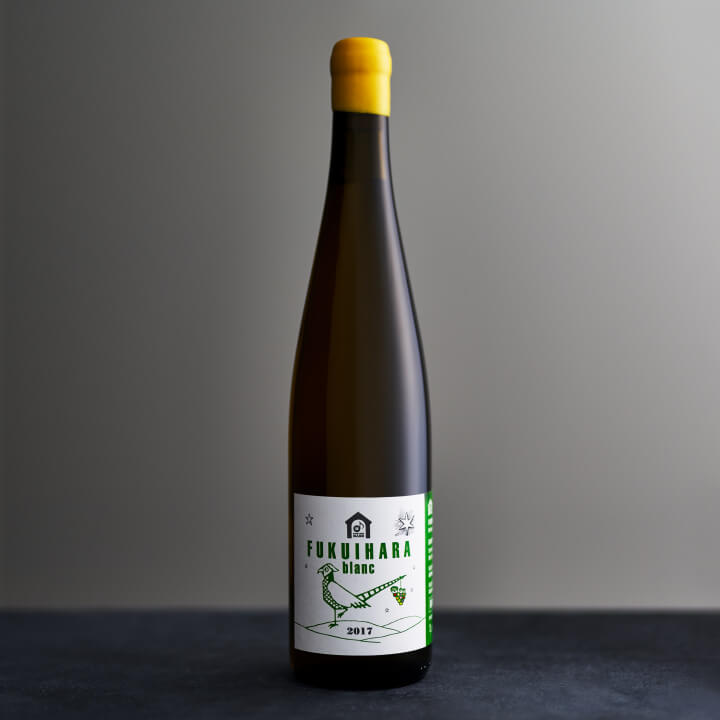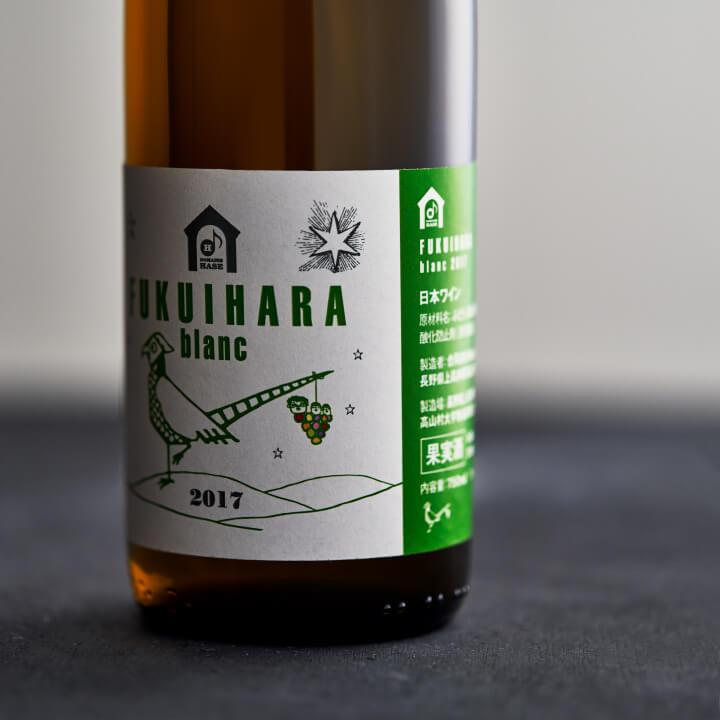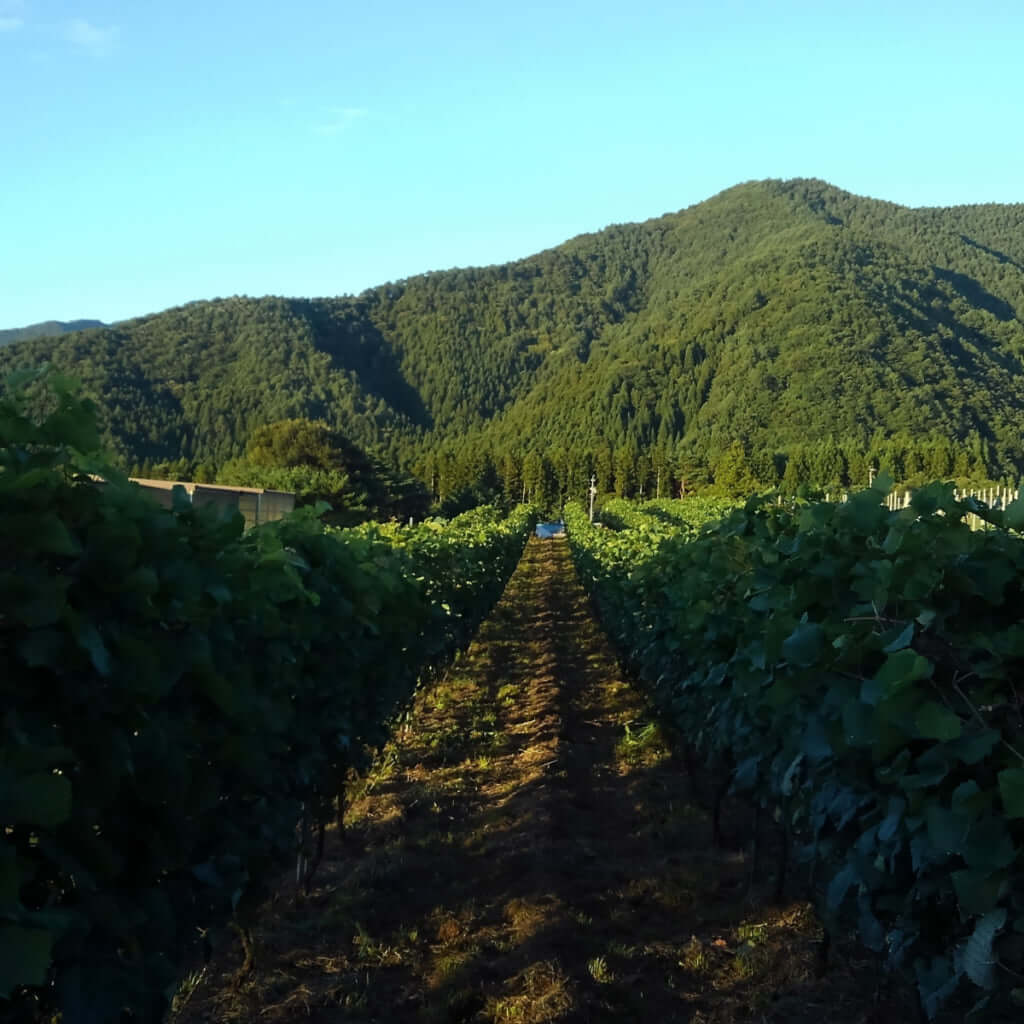A Richly Acidic White Wine, Resembling the Wines of Alsace
Fukuihara Blanc Domaine Hase

This wine is made by a vintner who has been charmed by the locality of Fukuihara. That wine is Fukuihara Blanc, which is introduced here. ‘The first time I visited, I instantly visualized the wasted hillside as a scene of an extensive vineyard, and I decided, ‘This is the place!’ Then I moved into the community’, recounts the vintner, Mitsuhiro Hase. That was 5 years ago, when Hase was looking for land suitable to the kind of wine he felt he wanted to make.
Fukuihara is in Takayama-mura, located on the right side of the Chikuma River that runs south and north through the northern part of Nagano Prefecture. The fields in this village are often cut into fan-shaped plots shaped like Japanese fans, and Fukuihara is at the tip of the fan shape, at an altitude of 790-850 m (2550-2750 ft.). Among Japanese vineyards, this is categorized as a cool climate vineyard.
Hase’s vision, then and now, is for ‘virtual Alsace wine’. Similar to the wines of the Alsace region, known as a cool producing region even for France, this is an elegant style characterized by a richly acidic taste. His approach is to make a ‘field blend’ by growing several different varieties on a single plot of land, harvesting them at the same time, then mixing and fermenting them together. Actually the number of wines produced by growing a mix of varieties together (interplanting), then followed by mixed fermentation (cofermentation) is slowly growing around the world.
Many of the winemakers who are taking this approach emphasize that, because interplanted grape vines are less susceptible to disease, it is possible to reduce or even eliminate agricultural chemicals. This, Hase believes, involves showing respect to the land. ‘To make wine from various grapes raised within a single field, co-existing with other forms of life such as microbes, reflects the natural power of the land in Fukuihara, and just like the splendid scenery, I want the wine to resonate with the heart’, says Hase.
Then there’s the wine. It’s fascinating to savor a mouthful while flavors such as white peach and citrus are released one after the other. Overall, it has a consistent taste and penetrates the body gently. Acid lurks behind in the shadows, tightening up the flavor like a basso continuo. Hase’s ideas are being communicated by taking the form of wine.


Domaine Hase
Area under direct cultivation: 6 ha
Name of fermenter: Mitsuhiro Hase
Variety and origin: Chardonnay, Sauvignon Blanc, Riesling, Gewurtztraminer, Chenin Blanc, Syrah.
Takayama-mura, Fukuihara (Oaza Makifukuihara, Takayama-mura, Kamitakai-gun, Nagano Prefecture)
Volume: 750 ml
Price: ¥2,106
Vinification: 1½ months fermentation with wild yeast. For this year, purchased chardonnay grapes (a cuvée that had not fermented for 3 weeks) and a 6-species mixed fermentation cuvée (skin contact in effect) were added during fermentation, this then continued to ferment. Total sulfites: 30 ppm. Because noble rot grapes had been mixed in, 200 ppm of sulfite was added during crushing to avoid risks. No filtering, no fining. No sulfite was added during bottling.
※ 65% of the purchased Chardonnay grapes were cultivated by customary methods, the remaining 35% was limited to lime sulfur during the dormant season and 5x spreading of Bordeaux mixture. No fertilization, non-tillage, cover-cropped cultivation.
www.facebook.com/domainehaseNOTE: The 'Natural Wines' series introduces naturalist wines and natural wines produced as naturally as possible over all stages from grape cultivation to fermentation. What exactly does 'as naturally as possible' mean? In this series, it means 'minimal human intervention' during the secondary fermentation process. It also means 'no addition of sulfites during primary fermentation and bottling', or perhaps 'sulfites limited to an absolute minimum amount', and 'depending on natural yeast, without using cultured yeast, without additives'. Other expectations include 'No sugars are added, no adjustment with acids, no finishing agents, and generally no filtration'. In terms of grape cultivation, the basic premise is to avoid using synthetic agricultural chemicals, but growing wine varietals in the Japanese climate by organic methods is extremely problematic at present, so keeping the use of agricultural chemicals to a bare minimum is a reasonable expectation. As a general rule, herbicides and chemical fertilizers should be completely avoided. To successfully make wine in this way, grapes must be kept robust, and conscientious oversight of the fermentation process is indispensable. The vintners who succeed in raising grapes as naturally as possible in respect of the terroir, and the wines that they produce, are the deserving subjects of this series.
TRENDING
-
A House from the Taisho Era Reveals Its Secrets
While visiting an abandoned building, Hamish Campbell discovered photographs the owner had taken of the place in the 1920s.

-
The Taboo-Breaking Erotica of Toshio Saeki
The master of the 1970s Japanese avant-garde reimagined his most iconic artworks for a limited box set with silkscreen artist Fumie Taniyama.

-
With Meisa Fujishiro, Tokyo's Nudes Stand Tall
In the series 'Sketches of Tokyo', the photographer revisits the genre by bringing it face to face with the capital's architecture.

-
Masahisa Fukase's Family Portraits
In his series ‘Family’, the photographer compiles surprising photos in which he questions death, the inescapable.

-
Hajime Sorayama's Futuristic Eroticism
The illustrator is the pioneer for a form of hyperrealism that combines sensuality and technology and depicts sexualised robots.





